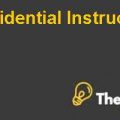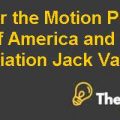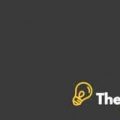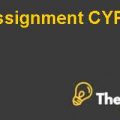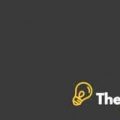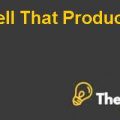Frank Spence Case Case Study Solution
Valuation
Frank’s business evaluation was performed by using discounted cash flow method. The estimations have been taken from 1995 till 2000 giving us 6 annual periods to work with. Forecasting procedure has been conducted after incorporating sales growth of 3% as assumed by Frank. Furthermore, according to him, the operating income would increase by 18% each year hence, giving us EBIT for each year. Subsequently, the free cash flow for each year has been calculated in the case. Moving forward, Chris had used different rate of return, 12%, 15% and 18%, as he thought 15% WACC might be controversial. Continuing with that, discounted cash flow has been calculated using all the three rate of return. This has been shown in exhibit 1. From the table, it can be seen that discounted free cash flows for 12% return are the highest.
After that, NPV of the three cash flows has been calculated as $9555, 000 for 12% rate, $6412, 000 or 15% rate and $4487, 000 for 18% rate of return. The total debt of the business is $2939, 000 which is subtracted from the three enterprise values. The subtraction has given us a range for worth of equity which is $8,187,000 till $1,787,000. The range can be negotiated in the deal by the buyer and Frank. Exhibit 3 shows the range of equity value.
Recommendations
Frank spencer is looking for the best price to sell of its small distribution company and to enjoy his retirement. In an effort to do so he has used his contact to discuss the issue with Chris Saunders, working in First United. Chris has asked the mergers and acquisition department of his bank to further discuss about mergers and acquisition. While discussing about the valuation process, Chris has asked Frank about the future projections, by using which the future six years forecasting has been completed. After valuation through DCF method, it can be seen that equity valuation for the different WACCs has given us a range from $8,187,000 till $1,787,000.
The company’s small size doesn’t allow it to get listed on the stock exchange therefore valuation has to be conducted in a different way. It is recommended that Frank and Chris should have adopted the benchmark evaluation method to compare his prices and valuation with others and hence Frank could’ve sold his product after looking at close competitors.
Exhibits
Exhibit 1
| 0 | 1 | 2 | 3 | 4 | 5 | 6 | Terminal Value | |
| 1994 | 1995 | 1996 | 1997 | 1998 | 1999 | 2000 | ||
| EBIT (Operating Income) | $4,971 | $4,993 | $5,143 | $5,297 | $5,456 | $5,620 | $5,788 | $5,788 |
| tax | $1,997 | $2,057 | $2,119 | $2,182 | $ 2,248 | $ 2,315 | $ 2,315 | |
| Free Cash Flow | $1,559 | $2,959 | $3,047 | $ 3,139 | $3,232 | $3,329 | $3,429 | $ 3,473 |
| Discounted free cash flow (12%) | $ 1,559 | $ 2,642 | $ 2,429 | $ 2,234 | $ 2,054 | $ 1,889 | $ 1,737 | $ 1,760 |
| Discounted free cash flow (15%) | $ 1,559 | $ 2,297 | $ 1,837 | $ 1,469 | $ 1,174 | $ 939 | $ 751 | $ 761 |
| Discounted free cash flow (18%) | $ 1,559 | $ 1,947 | $ 1,319 | $ 894 | $ 606 | $ 411 | $ 278 | $ 282 |
Exhibit 2
| Drug Wholesalers Publicly Traded Company Analysis | |||||||||||||||||||||||
| ($ In Millions) | |||||||||||||||||||||||
| Rank | Company | State | 5/30196 Stock Price |
Market Value (A) of Equity | Not Debt(B) | Enterprise Value (C) | LTM Sales |
LTM Operating Margin (D) |
Enterprise Value Multiple: Forward Operating PIE Sales EBITDA Income |
Market Value Multiple Net Book Income Value |
|||||||||||||
| 1 | McKesson Corp. (MCK)(E) | CA | $43.63 | $1,916.40 | $485.60 | $2.402.0 | $13,189.00 | 1.9% | 14.40 | 0.18 x | 7.37 x | 9.58 x | 14.41 x | 1.83 x | |||||||||
| 2 | Bergen Brunswig Corp. (BBC) | CA | 22.580 | 882.4 | 406.2 | 1,288.6 | 7,871.0 | 1.6% | 13.80 | 0.16 | 9.25 | 10.47 | 14.01 | 1.87 | |||||||||
| 3 | Cardinal Health Inc. (CAH) | OH | 46.000 | 1,926.0 | 325.4 | 2,251.4 | 5.790.0 | 2.4% | 22.55 | 0.39 | 13.68 | 16.10 | 55.03 | 3.85 | |||||||||
| 4 | FoxMeyer Health Corp. (FOX) | TX | 18.125 | 308.5 | 320.3 | 628.8 | 5,177.0 | 1.1% | 9.80 | 0.12 | 5.92 | 10.68 | 7.34 | 0.61 | |||||||||
| 5 | AmeriSource Health Corp. (ASH | PA | 22.250 | 300.4 | 620.3 | 920.7 | 4.726.0 | 2.0% | NM | 0.19 | 8.71 | 9.73 | NM | NM | |||||||||
| 6 | Brindle Western Industries (BIND | IN | 15.500 | 167.9 | 166.2 | 334.1 | 4,231.0 | 0.8% | 11.57 | 0.08 | 7.95 | 10.28 | 11.19 | 0.93 | |||||||||
| 7 | Owens & Minor Inc. HIdg. (OMI)( | VA | 13.000 | 399.2 | 323.3 | 722.5 | 2.752.0 | 2.0% | 15.85 | 0.26 | 10.47 | 12.90 | 10.54 | 1.59 | |||||||||
| 8 | D & K Wholesale Drug Inc. (DKW | MO | 6.125 | 16.5 | 17.3 | 33.8 | 320.0 | 1.2% | 12.01 | 0.11 | 6.91 | 8.90 | 16.54 | 2.36 | |||||||||
| 9 | Moore Medical Corp. (MMD) | CT | 11.375 | 32.6 | 23.7 | 56.2 | 277.0 | 2.7% | 9.25 | 0.20 | 6.25 | 7.50 | 10.84 | 1.41 | |||||||||
| High | 2.7% | 22.55 | 0.39 | 13.68 | 16.10 | 55.03 | 3.85 | ||||||||||||||||
| Mean | 1.7% | 13.65 | 0.19 | 8.50 | 10.68 | 17.49 | 1.81 | ||||||||||||||||
| Median | 1.9% | 12.91 | 0.18 | 7.95 | 10.28 | 12.60 | 1.71 | ||||||||||||||||
|
0.8% | 9.25 | 0.08 | 5.92 | 7.50 | 7.34 | 0.61 | ||||||||||||||||
Exhibit 3
| 12% | 15% | 18% | |
| NPV of Cash Flow | $ 9,555.33 | $ 6,412.64 | $ 4,487.63 |
| NPV of Terminal Value | $ 1,571.01 | $ 661.47 | $ 238.80 |
| Enterprise Value | $ 11,126.34 | $ 7,074.12 | $ 4,726.43 |
| Debt | $ 2,939.00 | $ 2,939.00 | $ 2,939.00 |
| Equity Value | $ 8,187.34 | $ 4,135.12 | $ 1,787.43 |
Exhibit 4
| cost of debt | 8.2% |
| cost of equity | 17.6% |
| debt | $ 2,939.00 |
| equity | 4552 |
| tax | 40% |
| wd | 0.39 |
| We | 0.61 |
| WACC | 12.62% |

